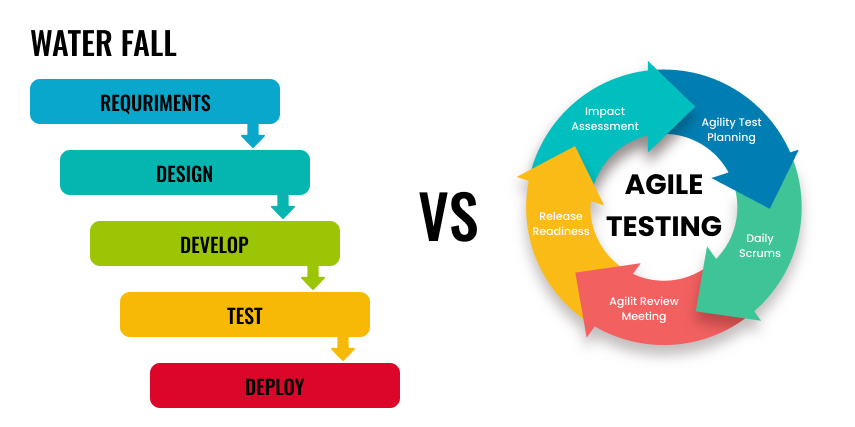Agile vs. Waterfall: Choosing the Right Project Management Approach for Your Team
April 25, 2024

Table of Contents
As a project manager for a digital product or a software developer for a SaaS project, you must have somehow known the ongoing debate about Agile vs. Waterfall. The theoretical explanations may bog you down. Let us not talk about that, however, it is crucial you know the two best project management aspects that create a phenomenal impact on any company’s progress.
Knowing which is the best – Agile or Waterfall is actually a big deal. For any digital project management, you must first examine these core methodologies as they will help you finalize one. Also, a lot depends on the kind of project you have on hand. Let us find out some key differences between Agile and Waterfall. We will also understand when to use these technologies and when you can even combine them in a project.
Key Difference Between Agile and Waterfall
Agile is forever adaptive to changes and delivers work in iterations and increments. Whereas, Waterfall focuses on planning all the requirements first, gathers resources, and begins with the project. This leaves very little room to change or become flexible thereafter.
Waterfall projects just begin from the start and end up at the finish point, adhering to the structured process and deliverable schedules. In contrast, Agile project management does not define any prescribed list of requirements at the initial stage. The team is not bound to practice documentation and follow a structured pattern. Rather, the team works on adding value to the customer’s needs.
| Project Aspect | Agile | Waterfall |
|---|---|---|
| Project Life Cycle | Moves around discovery, development, testing, and iteration | Very linear and sequential. Well structured from beginning to end |
| Documentation | Not fixed. Very limited | Comprehensive |
| Customer Engagement | Closely works with customers through collaboration through a feedback loop continuously | Limited customer involvement. Provides feedback on key deliverables |
| Procedures | Light | Process-oriented |
Waterfall Methodology

It is one of the most traditional methodologies applied in software development. It is a linear methodology, consisting of well-defined phases that include planning, design, development, testing, and deployment. Just like a waterfall, the development process flows according to the phases defined. One cannot go back and make changes. This method is suitable for projects having predefined stages and does not need any iterations in the middle.
However, the real world is different. This method is often rigid and is considered an old-school approach. To take the benefit out of this technique, the only way is effective communication during each phase and Waterfall methodology can become a perfect hit.
Pros
- Waterfall methodology prefers gathering requirements upfront. The team of developers and clients finalize the deliverable upfront and simply follow the structured plan and design. They measure progress against the key deliverables list in the ongoing project. All this is comprehensively documented, making it easier for the new programmers to implement easily.
- The entire project is divided into different sequential phases that are executed one after the other. Through a structured workflow, it becomes easier to measure the progress and find out loopholes against the well-defined milestones structured at the very beginning of the project.
- A straightforward testing process is implemented, referring to the specific use cases in the past and as defined in the functional specifications at the end of the product development phase.
- Clients and stakeholders have minimum involvement except for product reviews, approvals, and status meetings.
Cons
- All the stakeholders are involved meagerly to provide feedback in the earlier stage of the project life cycle. This hampers the possibilities to know whether the product would generate customer satisfaction or not. This limits the time as well as the budget to iterate as per the customer feedback.
- This methodology is not flexible enough to apply learnings to the ongoing project phase and make the necessary course of action. Hence, the reality differs from the planned action. Waterfall nature itself contradicts the adaptability principle. So it is difficult to make changes during the execution even if they are found to be necessary.
- The delayed testing phase might hamper identifying issues.
- The well-structured nature might prolong the project duration and delay the time-to-market gaps
Use Cases of Waterfall
- Software development projects for which requirements are previously well-defined.
- Event planning especially when all the phases are already followed in a logical order.
- Supply chain management where each stage is already defined in an order
Agile Methodology

Agile methodology is an iterative approach to software development. There is no perfect plan or a predefined set of phases at the beginning of the project. Unlike the Waterfall methodology, the Agile approach is to work in short iterations. Each iteration is converted into a valuable software piece, allowing developers to respond quickly to the changes as per the stakeholder’s requirements and feedback. This ensures the product is developed as per the needs and is well-refined.
In addition to working in short iterations, the Agile approach also embraces change and collaboration. The entire team is involved in the development process, ensuring each of them has well understood every part of the process and the way it is built. In addition, everyone can contribute their ideas and perspectives, including developers, designers, stakeholders, and product managers.
Implementing Agile can be challenging and demands deep expertise and sound knowledge. For larger organizations, this is a challenge, however, it is known that Agile development has always been a better choice over Waterfall. The Agile approach is a perfect combination of experimentation, collaboration, and consistent improvement.
Pros
- Instead of focusing on processes and tools, more focus is given to individuals and communication methodologies. The Agile teams are expected to be self-learners in terms of organizing workflows and they must show the ability to make decisions collaboratively within prescribed timeframes.
- More focus is given to obtaining shippable products rapidly instead of spending time on documentation that will certainly change over time.
- Agile methodologies focus more on client collaboration which includes working closely with them all through the project development cycle.
- Unlike the Waterfall approach, here change is observed as a friendly move, looking into its benefits and responding to it with a constructive approach.
- Making regular iterations promotes early identification of any issues and helps in mitigating them.
- The agile approach facilitates quicker time to market which means rapid product release.
Cons
- Lack of following project documentation may hamper effective delivery and does not help implement the same strategy for future projects.
- The pace of work may slow down due to the collaborative approach, wherein the committee does all the viewpoints and decision-making.
- Sometimes more time and resources are required to continue with the project and to make necessary iterations.
- Not suitable for projects that have well-defined requirements and need very less changes in the course of the project life cycle.
Use Cases
- For product development that needs to be pivoted according to the user interactions and responses.
- For software development where changes are done rapidly and iterative development is the key
- For marketing campaigns that need creating strategies according to the changing market trends.
- For teams exploring newer ideas and are open to testing and iterating to find new solutions and products.
Top companies using Agile methodology
- IBM
- Microsoft
- Apple
- Cisco
- Procter and Gamble
When to Use Agile Methodology over Waterfall
It is all up to the kind of project and the project manager. Your projects are based on the kind of processes followed by the organization and the readiness of the team to adapt to changing situations. In addition, every project has different requirements. The more you know about the project, the better clarity you gain about its approach. However, the below factors play a larger role in deciding when to choose Agile methodology over Waterfall:
- Project size
- Complexity
- Timeline
- Organization working patterns
- Type of clients, stakeholders, external and internal
How is Agile Better Than Waterfall?
Living in this world of constant changes and iterations happening every minute, choosing the agile methodology is the most suitable. The principles of Agile methodology are more adaptive in the digital world. It can fulfill various evolving requirements and changes needed.
- Performing regular reviews and making iterations at the same time will help keep track of the project and its success.
- Involving clients closely in the project for review and work prioritization will prevent last-minute surprises.
- Earlier collaboration in the project life cycle facilitates improvement in problem-solving capabilities and avoids surprises in the end
- With the changing scope or requirements the project gets quickly reviewed and Agile models will provide better ways to respond to the changes
What is a Hybrid Project?

It is not so easy to fully practice Agile methodology. It needs quick implementation with accuracy and readiness to make iterations in the right direction. Some clients may not prefer Agile as it may hit hard on their budget and timelines.
Implementing a hybrid project can work in such cases. This method creates an ideal balance of flexibility and defined structure. Teams can quickly adapt to the changes as well as they can efficiently manage the changing project requirements while delivering high-quality products.
In hybrid development, the project requirements are divided into various components. This is not a pure agile development, hence, it needs a partial commitment of formal planning, design, and documentation. With this, the projects remain on track and the team gets a clear vision of what resources are necessary.
Like Agile, hybrid development is scalable and ideal for projects of all sizes and complexities. Teams can collaborate in large numbers comprising stakeholders and developers, bringing in more sense of ownership of the final product.
Hybrid development is a perfect blend of both methodologies, giving two best worlds to developers. To get an adaptive, well-organized, and collaborative approach, you can always choose a hybrid methodology.
How to Choose the Right Project Development Methodology?
- Always consider the team size and scope of your project.
- Small teams with limited projects can adopt Waterfall. Large teams with open-ended projects must choose the Agile way.
- Figure out the working patterns of your team. For example, remote teams always must choose the Agile way to ensure perfect communication
- Consider the familiarity of your current team regarding methodologies.
- Projects anticipating frequent changes will need a more flexible approach which is found in Agile
- Consider the budget and timeline of the project. Agile suits best for building MVP. The waterfall is suitable for fixed-scope projects with limited budgets.
- Choose the methodology in tune with the business objectives and customer expectations.
Even after knowing the basics about Agile vs. Waterfall methodologies, if you are worried and struggling to find the perfect fit, you can always talk to our experts. At Softqube Technologies, we have provided amicable and result-driven solutions to our clients by developing small to complex projects. We have expertise in developing projects for Agile as well as for Waterfall methodologies. Our team of project managers will always help you to get on the right track. Choosing the right methodology is crucial for your team and also for the project. Get in touch with our talented team of project managers who are keen to help you find the perfect balance between flexibility and structure.
Share on







